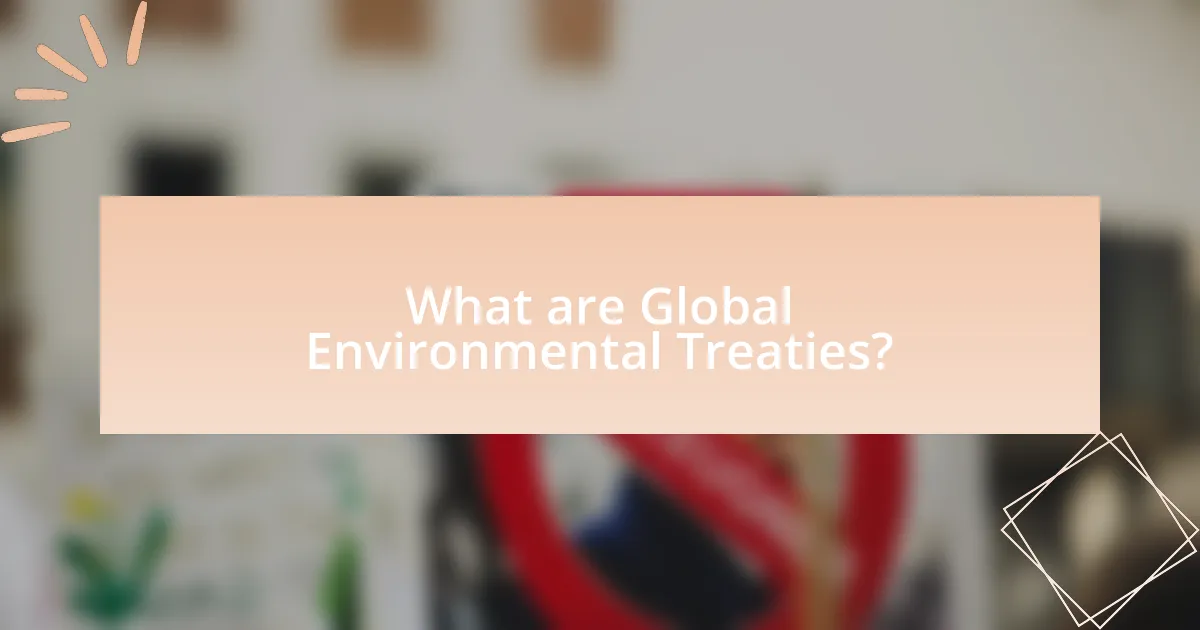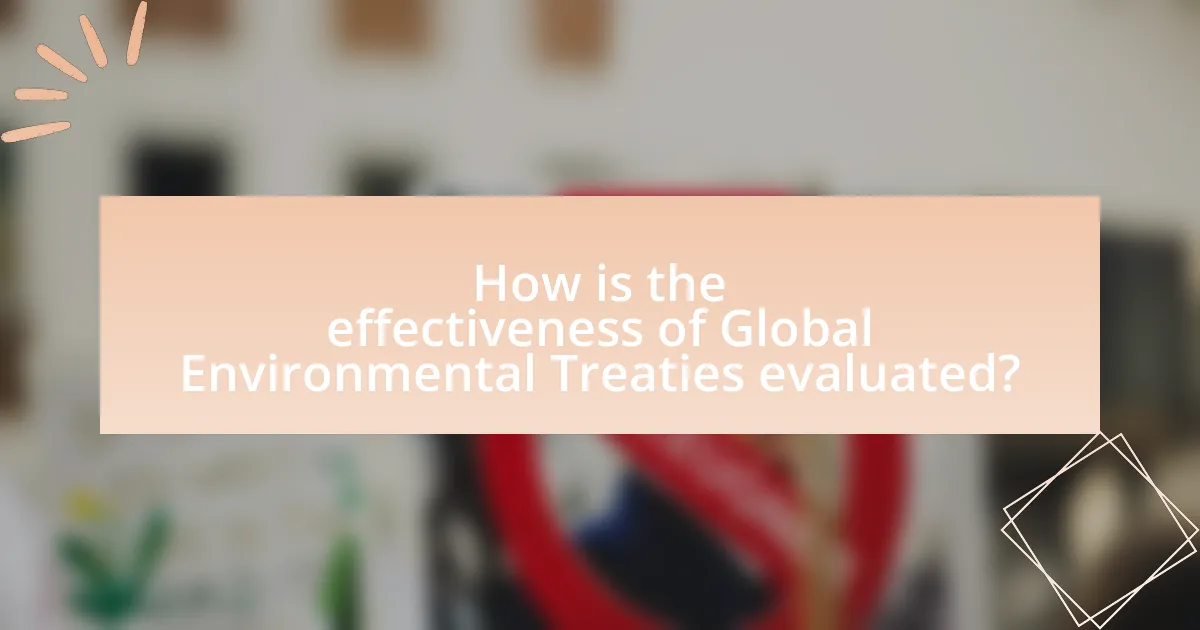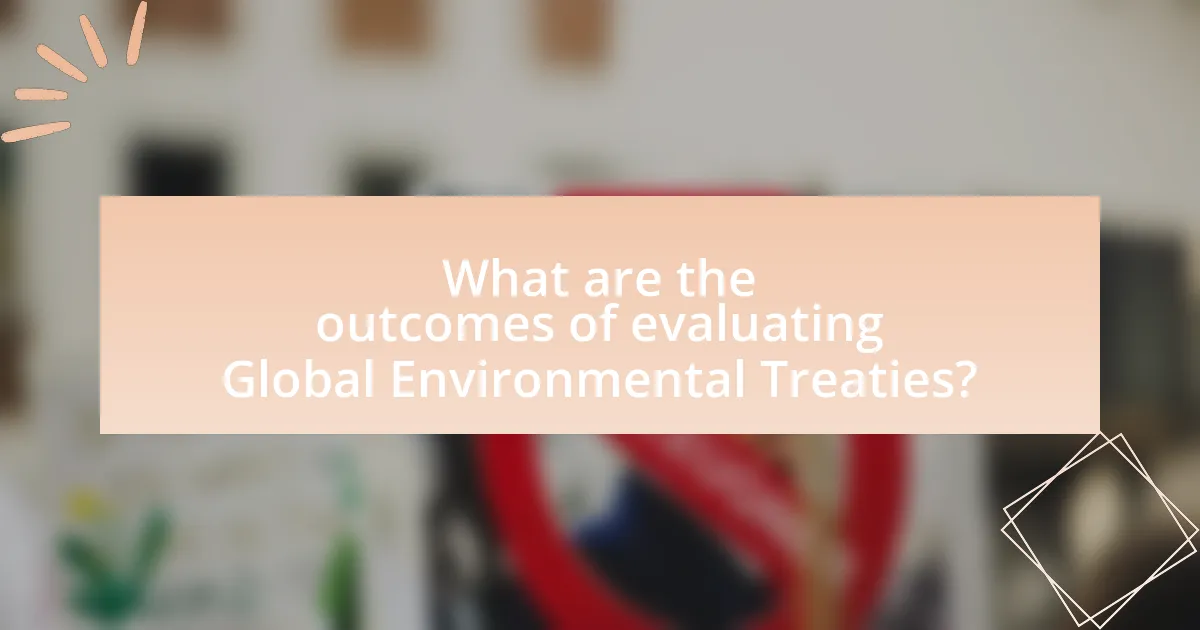Global Environmental Treaties are legally binding agreements between nations designed to address transnational environmental issues such as climate change, biodiversity loss, and pollution. This article evaluates the effectiveness of these treaties by examining their key components, including compliance mechanisms, monitoring processes, and stakeholder engagement. It discusses the importance of measurable outcomes and methodologies used in assessments, highlighting successes and failures of treaties like the Paris Agreement and the Montreal Protocol. Additionally, the article explores best practices for enhancing treaty effectiveness and the role of continuous monitoring in achieving environmental goals.

What are Global Environmental Treaties?
Global Environmental Treaties are legally binding agreements between countries aimed at addressing environmental issues that transcend national borders. These treaties, such as the Paris Agreement and the Convention on Biological Diversity, establish commitments for nations to reduce pollution, conserve biodiversity, and combat climate change. The effectiveness of these treaties can be evaluated through their implementation success, compliance rates, and measurable environmental outcomes, such as reductions in greenhouse gas emissions or improvements in species conservation.
How do Global Environmental Treaties function?
Global Environmental Treaties function by establishing legally binding agreements between countries to address environmental issues on a global scale. These treaties set specific targets, obligations, and frameworks for cooperation, enabling nations to collectively tackle challenges such as climate change, biodiversity loss, and pollution. For example, the Paris Agreement, adopted in 2015, commits countries to limit global warming to well below 2 degrees Celsius, with nations submitting nationally determined contributions (NDCs) to outline their climate action plans. The effectiveness of these treaties is often evaluated through mechanisms such as reporting requirements, compliance assessments, and periodic reviews, which help ensure accountability and progress towards environmental goals.
What are the key components of Global Environmental Treaties?
The key components of Global Environmental Treaties include legally binding commitments, specific targets and timelines, mechanisms for monitoring and reporting, financial and technical support provisions, and dispute resolution processes. Legally binding commitments ensure that countries are held accountable for their environmental obligations, while specific targets and timelines provide clear goals for reducing pollution or conserving biodiversity. Mechanisms for monitoring and reporting allow for transparency and assessment of progress, and financial and technical support provisions facilitate assistance to developing nations in meeting their treaty obligations. Dispute resolution processes are essential for addressing conflicts that may arise between parties regarding compliance or interpretation of treaty terms.
How do these components interact to achieve environmental goals?
The components of global environmental treaties, including legal frameworks, compliance mechanisms, and stakeholder engagement, interact synergistically to achieve environmental goals. Legal frameworks establish binding commitments for countries to reduce pollution and protect biodiversity, while compliance mechanisms, such as reporting requirements and penalties for non-compliance, ensure accountability. Stakeholder engagement, involving governments, NGOs, and local communities, fosters collaboration and enhances the implementation of treaty provisions. For instance, the Paris Agreement’s structure encourages nations to set and update their climate targets, promoting collective action towards limiting global warming. This interaction of components creates a comprehensive approach that drives progress in environmental protection and sustainability.
Why are Global Environmental Treaties important?
Global Environmental Treaties are important because they establish legally binding commitments among countries to address environmental issues that transcend national borders. These treaties facilitate international cooperation, enabling nations to collectively tackle challenges such as climate change, biodiversity loss, and pollution. For instance, the Paris Agreement, adopted in 2015, aims to limit global warming to well below 2 degrees Celsius, demonstrating a unified global effort to mitigate climate impacts. Additionally, treaties like the Convention on Biological Diversity provide frameworks for protecting ecosystems and species, highlighting their role in preserving global biodiversity. Such agreements are essential for coordinating actions, sharing resources, and ensuring accountability among nations, ultimately leading to more effective environmental governance.
What environmental issues do these treaties address?
Global environmental treaties address issues such as climate change, biodiversity loss, deforestation, pollution, and ocean degradation. For instance, the Paris Agreement specifically targets climate change by aiming to limit global warming to well below 2 degrees Celsius. The Convention on Biological Diversity focuses on the preservation of biodiversity and sustainable use of natural resources. Additionally, treaties like the Stockholm Convention on Persistent Organic Pollutants aim to reduce harmful chemicals in the environment. These treaties are designed to mitigate environmental degradation and promote sustainable practices globally.
How do Global Environmental Treaties contribute to sustainable development?
Global Environmental Treaties contribute to sustainable development by establishing legally binding commitments among nations to protect the environment and promote sustainable practices. These treaties, such as the Paris Agreement and the Convention on Biological Diversity, facilitate international cooperation, enabling countries to share resources, technology, and best practices for environmental protection. For instance, the Paris Agreement aims to limit global warming to well below 2 degrees Celsius, which directly supports sustainable development goals by addressing climate change impacts on ecosystems and human societies. Additionally, these treaties often include mechanisms for monitoring and reporting progress, ensuring accountability and encouraging nations to adopt sustainable policies that align with global environmental standards.

How is the effectiveness of Global Environmental Treaties evaluated?
The effectiveness of Global Environmental Treaties is evaluated through a combination of quantitative and qualitative assessments, including compliance rates, environmental impact assessments, and the achievement of specific treaty goals. Compliance rates are measured by analyzing the extent to which countries adhere to treaty obligations, often using data from monitoring bodies and reports. Environmental impact assessments evaluate the actual changes in environmental conditions resulting from treaty implementation, such as reductions in greenhouse gas emissions or improvements in biodiversity. Additionally, the achievement of specific treaty goals is assessed through established indicators and benchmarks, which provide a framework for measuring progress over time. For example, the Paris Agreement’s effectiveness is evaluated based on countries’ Nationally Determined Contributions (NDCs) and their progress toward limiting global warming.
What criteria are used to assess the effectiveness of these treaties?
The criteria used to assess the effectiveness of global environmental treaties include compliance rates, environmental outcomes, and the ability to achieve stated objectives. Compliance rates measure how well countries adhere to treaty obligations, which is crucial for evaluating commitment. Environmental outcomes assess the actual improvements in environmental conditions resulting from the treaty, such as reductions in pollution levels or biodiversity loss. The ability to achieve stated objectives involves analyzing whether the treaty has met its goals, such as emission reduction targets or conservation benchmarks, which can be supported by data from monitoring programs and scientific assessments.
How do compliance rates influence the evaluation of effectiveness?
Compliance rates directly influence the evaluation of effectiveness by serving as a key indicator of whether the objectives of global environmental treaties are being met. High compliance rates typically suggest that countries are adhering to the agreed-upon regulations, which can lead to positive environmental outcomes, thus demonstrating the treaty’s effectiveness. Conversely, low compliance rates indicate a failure to implement necessary measures, undermining the treaty’s goals and suggesting ineffectiveness. For instance, the Kyoto Protocol’s effectiveness was assessed through compliance rates, revealing that countries with higher adherence achieved greater reductions in greenhouse gas emissions, supporting the correlation between compliance and effectiveness.
What role do measurable outcomes play in assessing treaty success?
Measurable outcomes are critical in assessing treaty success as they provide quantifiable data to evaluate the effectiveness of treaty implementation. These outcomes allow stakeholders to track progress against specific goals, such as reductions in greenhouse gas emissions or improvements in biodiversity. For instance, the Kyoto Protocol established binding targets for developed countries, and measurable outcomes, such as emission reduction statistics, were essential in determining compliance and overall effectiveness. By analyzing these outcomes, policymakers can identify areas of success and failure, facilitating informed decisions for future treaties and amendments.
What methodologies are employed in the evaluation process?
The methodologies employed in the evaluation process of global environmental treaties include qualitative assessments, quantitative analyses, and mixed-method approaches. Qualitative assessments often involve case studies and expert interviews to gather insights on treaty implementation and effectiveness. Quantitative analyses utilize statistical methods to evaluate data on environmental indicators, compliance rates, and treaty impacts. Mixed-method approaches combine both qualitative and quantitative data to provide a comprehensive understanding of treaty effectiveness. These methodologies are validated by their widespread use in academic research and policy evaluations, such as the studies conducted by the United Nations Environment Programme, which emphasize the importance of diverse evaluation techniques in assessing treaty outcomes.
How do qualitative and quantitative methods differ in evaluating treaties?
Qualitative and quantitative methods differ significantly in evaluating treaties by focusing on different types of data and analysis. Qualitative methods emphasize understanding the context, motivations, and implications of treaties through interviews, case studies, and document analysis, allowing for in-depth insights into stakeholder perspectives and the social dynamics surrounding treaty implementation. In contrast, quantitative methods rely on numerical data and statistical analysis to measure treaty outcomes, effectiveness, and compliance rates, often using surveys, metrics, and models to provide objective assessments. For instance, a study evaluating the effectiveness of the Paris Agreement may use qualitative interviews to explore participant experiences while employing quantitative data to analyze greenhouse gas emission reductions. This distinction highlights how qualitative methods capture the nuanced human elements of treaty evaluation, whereas quantitative methods provide measurable evidence of treaty impacts.
What are the challenges associated with measuring treaty effectiveness?
Measuring treaty effectiveness faces several challenges, primarily due to the complexity of environmental issues and the variability in implementation among signatory states. One significant challenge is the lack of standardized metrics for assessing compliance and outcomes, which complicates comparisons across different treaties. Additionally, the influence of external factors, such as economic conditions and political will, can skew results, making it difficult to attribute changes directly to treaty provisions. Furthermore, data availability and quality often hinder accurate assessments, as many countries may not report environmental data consistently or transparently. These challenges underscore the need for robust frameworks and methodologies to evaluate the effectiveness of global environmental treaties accurately.

What are the outcomes of evaluating Global Environmental Treaties?
Evaluating Global Environmental Treaties leads to several key outcomes, including improved compliance, enhanced environmental protection, and informed policy adjustments. These evaluations assess treaty effectiveness by analyzing data on emissions reductions, biodiversity conservation, and resource management. For instance, the Kyoto Protocol’s evaluation revealed a 22% reduction in greenhouse gas emissions among participating countries, demonstrating the treaty’s impact on climate change mitigation. Additionally, evaluations often highlight areas for improvement, guiding future treaty negotiations and implementations to address emerging environmental challenges effectively.
What successes have been achieved through these treaties?
Global environmental treaties have achieved significant successes, including the reduction of ozone-depleting substances through the Montreal Protocol, which led to a 98% decrease in the consumption of these substances since its adoption in 1987. Additionally, the Paris Agreement has fostered international cooperation, resulting in commitments from nearly 200 countries to limit global warming to well below 2 degrees Celsius, with many nations implementing national climate action plans. These treaties have also facilitated the protection of biodiversity, as seen in the Convention on Biological Diversity, which has helped establish protected areas covering over 15% of terrestrial and inland water areas globally.
Which treaties have shown significant positive environmental impacts?
The Montreal Protocol has shown significant positive environmental impacts by successfully phasing out substances that deplete the ozone layer. Since its adoption in 1987, the treaty has led to a substantial reduction in the use of chlorofluorocarbons (CFCs) and other ozone-depleting chemicals, resulting in the recovery of the ozone layer. According to the United Nations, the protocol is expected to prevent an estimated 2 million cases of skin cancer annually by 2030 due to the reduction of harmful ultraviolet radiation reaching the Earth’s surface. Additionally, the treaty has contributed to climate change mitigation by avoiding the release of greenhouse gases, as many ozone-depleting substances are also potent climate forcers.
How have these successes influenced global environmental policy?
Successes in global environmental treaties have significantly influenced global environmental policy by establishing frameworks for international cooperation and setting binding targets for emissions reductions. For instance, the Paris Agreement, adopted in 2015, has led to countries committing to limit global warming to well below 2 degrees Celsius, which has prompted nations to develop national climate action plans. This success has encouraged further commitments, such as the Glasgow Climate Pact in 2021, which reinforced the urgency of climate action and called for enhanced transparency and accountability. These milestones demonstrate how successful treaties can catalyze stronger environmental policies and foster a collaborative approach to addressing climate change on a global scale.
What failures or shortcomings have been identified?
Failures and shortcomings identified in global environmental treaties include inadequate enforcement mechanisms, lack of binding commitments, and insufficient funding for implementation. For instance, the Kyoto Protocol, while a significant step, failed to achieve its emissions reduction targets due to non-compliance by major emitters like the United States and China. Additionally, many treaties lack specific, measurable goals, which hampers accountability and progress tracking. The Global Environment Facility has also been criticized for not providing enough financial resources to developing countries, limiting their ability to meet treaty obligations. These factors collectively undermine the effectiveness of global environmental agreements.
What factors contribute to the ineffectiveness of certain treaties?
Certain treaties can be ineffective due to a lack of enforcement mechanisms, insufficient commitment from signatory states, and ambiguous language that leads to varied interpretations. The absence of binding obligations often results in non-compliance, as seen in the Kyoto Protocol, where many countries failed to meet their emission reduction targets. Additionally, political and economic interests can overshadow treaty obligations, leading to selective adherence, as evidenced by the United States’ withdrawal from the Paris Agreement. Furthermore, inadequate funding and resources for implementation hinder the effectiveness of treaties, exemplified by the challenges faced by the Convention on Biological Diversity in achieving its goals.
How can lessons learned from failures improve future treaties?
Lessons learned from failures can significantly improve future treaties by providing critical insights into the shortcomings of previous agreements. For instance, the Kyoto Protocol, which aimed to reduce greenhouse gas emissions, faced challenges due to lack of binding commitments for major emitters like the United States and China. Analyzing these failures highlights the necessity for inclusive participation and enforceable targets in future treaties, such as the Paris Agreement, which incorporates a more flexible framework allowing countries to set their own emission reduction goals while still holding them accountable. This iterative learning process ensures that future treaties are more robust, adaptable, and effective in addressing global environmental issues.
What best practices can enhance the effectiveness of Global Environmental Treaties?
Best practices that can enhance the effectiveness of Global Environmental Treaties include establishing clear, measurable targets and timelines, ensuring robust monitoring and reporting mechanisms, and fostering stakeholder engagement. Clear targets enable countries to understand their commitments and track progress, as seen in the Paris Agreement, which sets specific greenhouse gas reduction goals for each nation. Robust monitoring, such as the use of satellite technology for deforestation tracking, allows for accountability and transparency, ensuring that countries adhere to their commitments. Engaging stakeholders, including local communities and businesses, promotes broader support and compliance, as demonstrated by the involvement of indigenous groups in the Convention on Biological Diversity. These practices collectively strengthen the implementation and impact of environmental treaties.
How can stakeholder engagement improve treaty outcomes?
Stakeholder engagement can improve treaty outcomes by fostering collaboration and ensuring diverse perspectives are considered in the decision-making process. Engaging stakeholders, such as local communities, NGOs, and industry representatives, enhances the legitimacy and acceptance of treaties, leading to more effective implementation. For instance, the Paris Agreement’s success is partly attributed to the involvement of various stakeholders, which helped align national commitments with local needs and capacities. This inclusive approach can lead to better compliance rates and innovative solutions, as stakeholders often possess valuable insights and resources that can enhance treaty effectiveness.
What role does continuous monitoring play in treaty effectiveness?
Continuous monitoring is essential for treaty effectiveness as it ensures compliance, facilitates timely interventions, and enhances accountability among parties. By systematically tracking the implementation of treaty obligations, continuous monitoring allows for the identification of non-compliance or emerging issues, which can be addressed promptly to prevent further degradation of environmental conditions. For instance, the Kyoto Protocol’s effectiveness was significantly bolstered by the establishment of mechanisms for monitoring greenhouse gas emissions, which provided data that informed policy adjustments and compliance measures. This data-driven approach reinforces the credibility of treaties and encourages adherence, ultimately contributing to their success in achieving environmental goals.